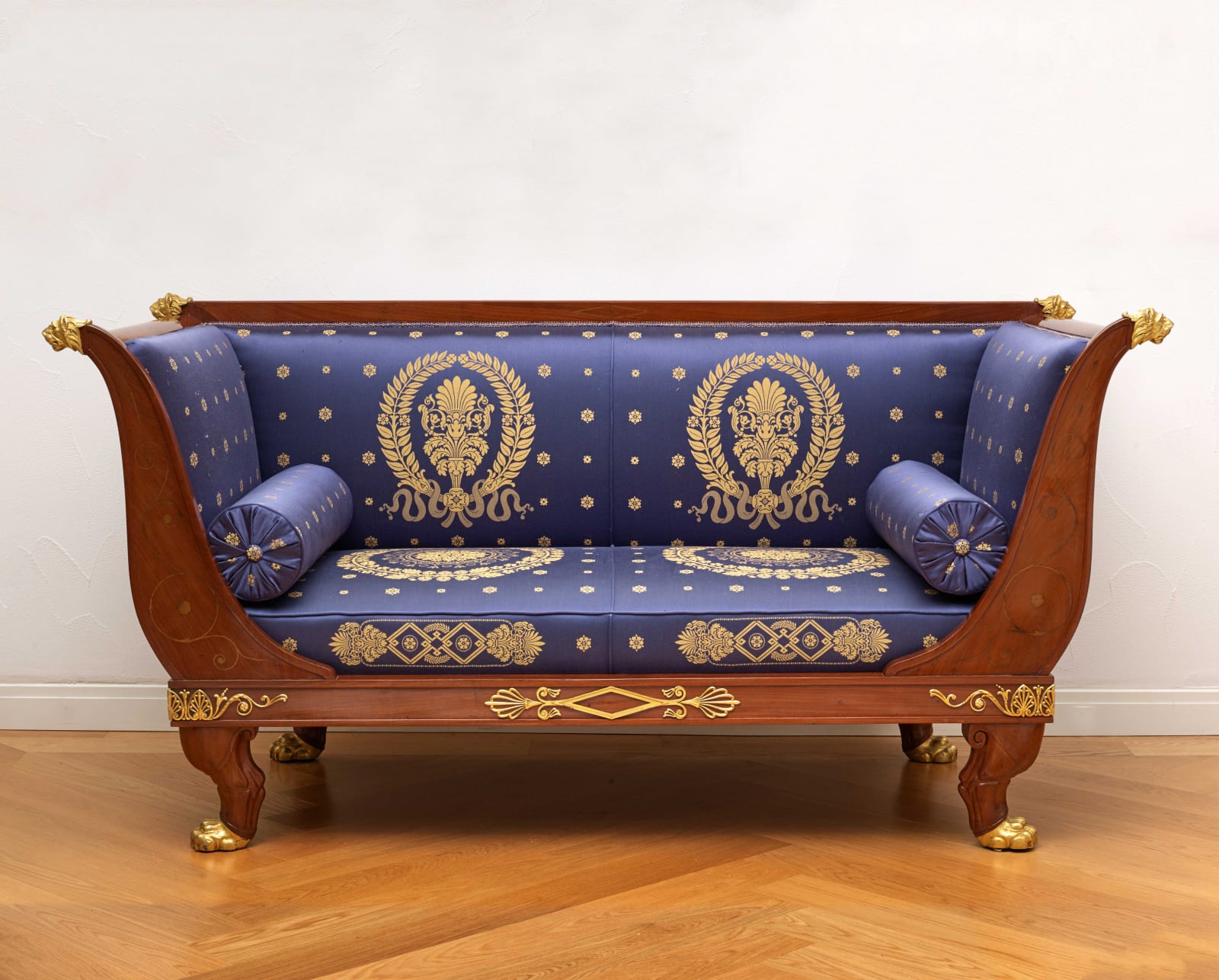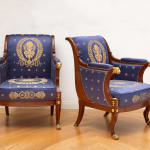Jacob-Desmalter et Cie
Further images
Provenance
Queen Hortense de Beauharnais (1783-1837), wife of Louis Bonaparte, King of Holland (1778-1846)
A very important and extremely fine suite of Empire gilt bronze mounted mahogany furniture comprising a pair of fauteuils, a pair of bergères and a canapé by the celebrated Parisian firm of ébénistes Jacob-Desmalter et Cie, stamped JACOB and also stamped with an H and a crown for the Garde-Meuble of Queen Hortense, the fauteuils and bergères each with a sweeping scrolled top rail above channelled frames with gilt bronze rosettes at the junction of the arm rests above further foliate and rosette mounts, the arms terminating in gilt bronze lion heads above front hermed legs on gilt bronze lion paw feet. The canapé with a sweeping scrolled top rail terminated by gilt bronze lion heads and similarly on the front side rails, the lower front rail centred by a diamond and acanthus mount and flanked at each end by lotus and foliate mounts above hermed legs on gilt bronze lion paw feet
Paris, date circa 1805
The canapé: length 180 cm, height 89 cm, depth 75 cm; the fauteuils: width 59 cm, height 90 cm, depth 52 cm. each; the bergères: width 67 cm, height 110 cm, depth 59 cm. each.
Not only was this suite made the leading firm of Empire ébénistes namely Jacob-Desmalter et Cie but it also boasts a very important provenance having been owned by Queen Hortense de Beauharnais. Beautiful, well educated and deeply interested in the arts, Hortense became Napoleon Bonaparte's step daughter when her mother Joséphine married him in 1796; Hortense also became Napoleon's sister-in-law when in 1802 she married his brother Louis Bonaparte. After Louis was crowned King of Holland in 1806 he and Hortense settled in The Hague but in 1810 he was forced to abdicate and they went their separate ways, with Louis moving to Germany and Hortense and their sons to France. Dividing her time between her children and travel, she also devoted herself to drawing, painting and music. After the restoration of the Bourbon monarchy Hortense was forced to flee France and in 1817 purchased Arenenberg Castle in the Swiss canton of Thurgau where she remained until her death in 1837. There she was surrounded by some of her finest furnishings, many of which can still be admired in situ including other pieces from this present suite.
As a member of the Imperial family, it was fitting that Hortense owned works by Jacob, who as the most important firm of ébénistes, supplied numerous furnishings to the Emperor's family. Included was a chair commissioned by Napoleon's uncle Cardinal Fesch, probably at the time he was appointed archbishop of Lyon in 1802. His chair, now in the Bibliothèque Municipale, Lyon (illustrated in L. de Groër, "Les Arts Décoratifs de 1790 à 1850", 1985, p. 133, pl. 242), shares similar characteristics with the present pieces in that it has scrolled arms terminating in lioness heads and hermed legs supported on lion paw feet. Jacob-Desmalter at rue de Meslée, Paris was founded by Georges Jacob (1739-1814), the greatest menuisier of the Louis XVI period.
Following his retirement in 1796, he was succeeded by his two sons Georges II (1768-1803) and François-Honoré-Georges Jacob (1770-1841), who worked under the name of Jacob Frères. Since Georges II died shortly after his brother, who added the suffix Desmalter (named after one of his father's properties in Burgundy), went back into business with his father and renamed the firm Jacob-Desmalter et Cie. During the Empire François-Honoré-Georges was described as menuisier-ébéniste, fabriquant des meubles et bronzes de LL., MM., II. et RR (Leurs Majestés Impériales et Royales), implying that he played an active role in the practical side of the firm's craftsmanship.
The firm's activities expanded enormously following Jacob-Desmalter's appointment as ébéniste de l'Empereur. Numerous commissions came from the Garde-Meuble Imperial to supply furniture to various Bonaparte residences, especially those belonging to Hortense's mother - the Empress Joséphine. The firm was also patronised by many notable figures and rich Parisian bourgeoisie; commissions also came from abroad, for instance from Tsar Alexander I of Russia and Charles IV of Spain. Among the firm's most important surviving items is the Imperial throne at Fontainebleau, the jewel cabinet made for Marie-Louise and display cases in the Cabinet des Antiques at the Bibliothèque Nationale, Paris. Jacob-Desmalter's work is also represented at the Châteaux de Compiègne, Fontainebleau, Malmaison, Versailles and Sceaux l'Ille-de-France as well as the Musées du Louvre, Marmottan, Mobile National, Grand Trianon, Napoléon and Tours.
In addition, the Bibliothèque Marmottan, Banque de France, Ministère des Affaires Etrangères and the Palais d'Aranjuez in Spain are among many others to house the firm's work. Despite phenomenal repute, the firm, like many in the luxury trade, suffered severely from the industrial crisis following the Peninsular War and Russian campaign. In 1813 Georges I Jacob retired, coinciding with the firm declaring bankruptcy. This however was short lived as business revived rapidly after the restoration of Louis XVIII in 1814, and continued up until 1847 when it was sold to Charles-Joseph-Marie Jeanselme.





